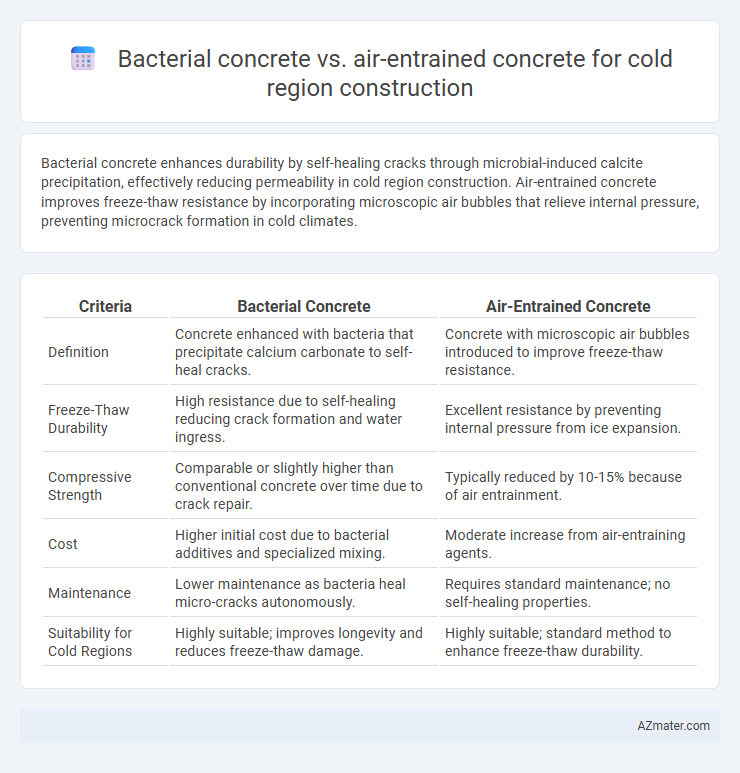Bacterial concrete enhances durability by self-healing cracks through microbial-induced calcite precipitation, effectively reducing permeability in cold region construction. Air-entrained concrete improves freeze-thaw resistance by incorporating microscopic air bubbles that relieve internal pressure, preventing microcrack formation in cold climates.
Table of Comparison
| Criteria | Bacterial Concrete | Air-Entrained Concrete |
|---|---|---|
| Definition | Concrete enhanced with bacteria that precipitate calcium carbonate to self-heal cracks. | Concrete with microscopic air bubbles introduced to improve freeze-thaw resistance. |
| Freeze-Thaw Durability | High resistance due to self-healing reducing crack formation and water ingress. | Excellent resistance by preventing internal pressure from ice expansion. |
| Compressive Strength | Comparable or slightly higher than conventional concrete over time due to crack repair. | Typically reduced by 10-15% because of air entrainment. |
| Cost | Higher initial cost due to bacterial additives and specialized mixing. | Moderate increase from air-entraining agents. |
| Maintenance | Lower maintenance as bacteria heal micro-cracks autonomously. | Requires standard maintenance; no self-healing properties. |
| Suitability for Cold Regions | Highly suitable; improves longevity and reduces freeze-thaw damage. | Highly suitable; standard method to enhance freeze-thaw durability. |
Introduction to Bacterial and Air-Entrained Concrete
Bacterial concrete incorporates specific microorganisms that precipitate calcium carbonate, enhancing durability and crack self-healing properties critical in cold region construction where freeze-thaw cycles are common. Air-entrained concrete contains microscopic air bubbles introduced through chemical admixtures, improving resistance to frost damage by providing relief spaces for expanding ice in freezing temperatures. Both technologies address freeze-thaw resilience but leverage distinct mechanisms: biological mineralization in bacterial concrete and physical air void systems in air-entrained concrete.
Key Properties of Bacterial Concrete
Bacterial concrete exhibits self-healing properties through microbial-induced calcite precipitation, enhancing durability and reducing permeability in cold regions where freeze-thaw cycles cause microcracks. Its superior crack resistance and ability to autonomously repair damage improve the lifespan of structures exposed to extreme temperatures and moisture variations. This makes bacterial concrete a sustainable option compared to air-entrained concrete, which primarily relies on entrapped air bubbles to improve freeze-thaw resistance but lacks self-repair mechanisms.
Characteristics of Air-Entrained Concrete
Air-entrained concrete contains microscopic air bubbles that improve its freeze-thaw resistance by providing space for water to expand when it freezes, significantly reducing internal stress and cracking in cold regions. This type of concrete enhances durability and reduces scaling caused by deicing salts, making it ideal for harsh winter climates. The controlled air void system also improves workability and reduces permeability, contributing to long-term structural performance in cold environments.
Performance in Cold Climate Environments
Bacterial concrete enhances durability in cold regions by promoting self-healing of microcracks and reducing chloride ion penetration, which prevents freeze-thaw damage. Air-entrained concrete improves freeze-thaw resistance by incorporating microscopic air bubbles that accommodate ice expansion, reducing internal stress. In cold climate construction, bacterial concrete offers long-term sustainability benefits, while air-entrained concrete provides immediate freeze-thaw stability and improved resistance to deicing chemicals.
Freeze-Thaw Resistance Comparison
Bacterial concrete exhibits enhanced freeze-thaw resistance in cold region construction due to its ability to self-heal microcracks via microbial-induced calcite precipitation, reducing water ingress and structural damage. Air-entrained concrete improves freeze-thaw durability by incorporating microscopic air bubbles that provide space for water expansion during freezing, thereby mitigating internal stresses and cracking. Comparative studies reveal bacterial concrete offers longer-term durability and lower maintenance costs, while air-entrained concrete remains a cost-effective, widely used solution for freeze-thaw mitigation.
Durability and Longevity Factors
Bacterial concrete enhances durability in cold regions by utilizing microbial-induced calcium carbonate precipitation that seals microcracks and reduces permeability, preventing freeze-thaw damage. Air-entrained concrete improves longevity by incorporating microscopic air bubbles that accommodate ice expansion, mitigating internal stress and cracking. While bacterial concrete offers self-healing properties that extend service life, air-entrained concrete remains a widely adopted solution to enhance freeze-thaw resistance in cold climate construction.
Strength Development and Structural Integrity
Bacterial concrete exhibits enhanced strength development in cold region construction due to the microbial-induced calcite precipitation that fills microcracks and pores, improving durability and structural integrity under freeze-thaw cycles. Air-entrained concrete improves freeze-thaw resistance by incorporating microscopic air bubbles that relieve internal pressure but generally shows lower compressive strength compared to bacterial concrete. The integration of bacterial concrete in cold climates yields superior structural performance by combining crack self-healing with higher load-bearing capacity, unlike air-entrained concrete which prioritizes freeze-thaw resilience at some cost to strength.
Environmental and Sustainability Aspects
Bacterial concrete utilizes microbial-induced calcite precipitation to self-heal cracks, significantly reducing maintenance needs and extending structural lifespan, which enhances environmental sustainability by lowering resource consumption. Air-entrained concrete improves freeze-thaw durability through microscopic air bubbles, minimizing damage in cold regions but does not actively repair cracks, potentially leading to more frequent repairs and resource use over time. The adoption of bacterial concrete in cold climates offers superior long-term environmental benefits by decreasing carbon footprint and material waste compared to conventional air-entrained concrete.
Cost Implications and Practical Considerations
Bacterial concrete, incorporating calcite-producing bacteria, offers self-healing properties that reduce long-term maintenance costs in cold regions prone to freeze-thaw damage, though initial production expenses remain higher compared to traditional air-entrained concrete. Air-entrained concrete, designed with microscopic air bubbles to improve freeze-thaw resistance, provides a cost-effective and widely-used solution with established mixing and curing protocols but may incur higher repair costs over time due to microcracking. Practical considerations favor bacterial concrete's sustainability and durability benefits for infrastructure with extended service life, while air-entrained concrete remains advantageous for budget-sensitive projects requiring proven performance and ease of implementation.
Conclusion: Best Choice for Cold Region Construction
Bacterial concrete demonstrates superior self-healing properties and enhanced durability by sealing cracks, which effectively mitigates freeze-thaw damage common in cold regions. Air-entrained concrete provides excellent resistance to freeze-thaw cycles by incorporating microscopic air bubbles that reduce internal pressure build-up during freezing. For cold region construction, the optimal choice depends on balancing self-healing capacity with freeze-thaw resistance, with bacterial concrete offering innovative longevity benefits and air-entrained concrete delivering proven performance against frost-related damage.

Infographic: Bacterial concrete vs Air-entrained concrete for Cold region construction
 azmater.com
azmater.com